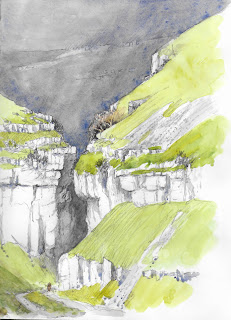Most of this year I've been painting subjects from the Middle East, a part of the world I've been fascinated by since I first visited in 1963, and these works will illustrate my forthcoming book, Arabian Light, due to be published by Search Press in May 2022. The subjects cover a wide variety of scenery, buildings, figures, interiors and many others, and for a taster I show below a painting of our expedition guides dancing in the desert hundreds of miles from the nearest village. For the intense darkness I've used the Daniel Smith Lunar black slightly mixed with French ultramarine. The granulation strength of this colour is truly mindblowing! There'll be more on this in future blogs.
Another book I'm pleased to be associated with is Green Parrots in my Garden, a book of poems from the Arab Middle East by Jane Ross, a Canadian poet who has lived in the Middle East amidst threats of war, but concerns herself more with the warmth of human relationships, the wisdom of ancient desert values and the beauties of artefact and design that bring her into the hearts of the people and the essence of the region. She writes of the oasis of Wadi Bani Khalid where 'the winds are gentle zephyrs in the thick warm air,'
'But ontop of Jebel Shyams the winds are sharp and piercing,
like needles thrusting their way through the blanket;
fiendish, dervish, absolute and wild.'
Yes, that mountain presented so many exciting images that I forgot myself in a fiery sunset, when the light vanished so suddenly that without a torch I found myself trying to pick up all my scattered brushes and pencils in the dark then navigate across a rock-strewn plateau on the edge of a canyon.
The books features two of my paintings in monochrome, and Jane's website is www.janeross.ca
It is available on Amazon via the link above.
I wish you all a very and peaceful Happy Christmas. May you have many lovely artful arty presents, and thanks for your patience in my extremely slow production rate in 2021













